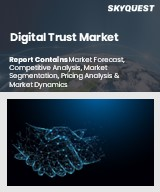
세계의 디지털 트러스트 시장 규모는 2023년에 3,446억 달러로 평가되며, 예측 기간(2025-2032년)의 CAGR은 19.1%로, 2024년 4,104억 2,000만 달러에서 2032년에는 1조 6,615억 8,000만 달러로 성장할 전망입니다.
세계 디지털 트러스트 시장은 금융, 헬스케어, E-Commerce, 정부 서비스 등의 분야에서 안전한 디지털 상호 작용에 대한 수요가 증가함에 따라 견고한 성장세를 보이고 있습니다. 기업이 디지털 전환 전략을 가속화함에 따라 디지털 시스템에 대한 소비자의 신뢰를 구축하고 유지하는 것이 매우 중요해지고 있습니다. GDPR(EU 개인정보보호규정), CCPA와 같은 규제 프레임워크가 강화되고 고도화된 사이버 위협이 증가함에 따라 기업은 신뢰성을 확보하고 사이버 리스크를 줄이기 위해 고급 인증, 데이터 프라이버시, ID 관리, 컴플라이언스 솔루션에 많은 투자를 하고 있는 것으로 분석되었습니다. 디지털 트러스트 프레임워크의 중요성이 더욱 커지고 있습니다. 또한 안전한 데이터 교환을 위한 AI, 클라우드 컴퓨팅, 블록체인에 대한 의존도가 높아지면서 이 시장 전망을 형성하고 있습니다. 기업은 제로 트러스트 아키텍처와 SASE(Secure Access Service Edge) 모델을 선호하고 있으며, 이는 디지털 신뢰의 기본 요소로서 경계 기반 보안에서 아이덴티티 중심 전략으로 전환하고 있음을 보여줍니다.
Global Digital Trust Market size was valued at USD 344.6 billion in 2023 and is poised to grow from USD 410.42 billion in 2024 to USD 1661.58 billion by 2032, growing at a CAGR of 19.1% during the forecast period (2025-2032).
The Global Digital Trust Market is witnessing robust growth, driven by the increasing demand for secure digital interactions across sectors such as finance, healthcare, e-commerce, and government services. As organizations accelerate their digital transformation strategies, the need to build and maintain consumer trust in digital systems has become critical. Our analysis reveals that businesses are heavily investing in advanced authentication, data privacy, identity management, and compliance solutions to establish credibility and reduce cyber risks. The rise in sophisticated cyber threats, along with stricter regulatory frameworks such as GDPR and CCPA, is further reinforcing the importance of digital trust frameworks. Additionally, growing reliance on AI, cloud computing, and blockchain for secure data exchange is shaping the future landscape of this market. Enterprises are increasingly prioritizing zero-trust architecture and secure access service edge (SASE) models, indicating a shift from perimeter-based security to identity-centric strategies as a foundational element of digital trust.
Top-down and bottom-up approaches were used to estimate and validate the size of the Global Digital Trust market and to estimate the size of various other dependent submarkets. The research methodology used to estimate the market size includes the following details: The key players in the market were identified through secondary research, and their market shares in the respective regions were determined through primary and secondary research. This entire procedure includes the study of the annual and financial reports of the top market players and extensive interviews for key insights from industry leaders such as CEOs, VPs, directors, and marketing executives. All percentage shares split, and breakdowns were determined using secondary sources and verified through Primary sources. All possible parameters that affect the markets covered in this research study have been accounted for, viewed in extensive detail, verified through primary research, and analyzed to get the final quantitative and qualitative data.
Global Digital Trust Market Segments Analysis
Global Digital Trust Market is segmented by Solution, Identity Type, Deployment, Enterprise Type, End-user and region. Based on Solution, the market is segmented into Fraud Detection and Prevention, Data Encryption and Security, Identity and Access Management, Digital Signatures and Certificate, Endpoint Security, Cloud Security, Risk and Compliance Management and Others. Based on Identity Type, the market is segmented into Centralized Identity, Decentralized Identity and Federated Identity. Based on Deployment, the market is segmented into On-premises and Cloud. Based on Enterprise Type, the market is segmented into Large Enterprises and Small and Medium Enterprises. Based on End-user, the market is segmented into BFSI, Government, Retails, Healthcare, IT & Telecom, Manufacturing, Energy & Utility and Others. Based on region, the market is segmented into North America, Europe, Asia Pacific, Latin America and Middle East & Africa.
Driver of the Global Digital Trust Market
The escalating frequency of cyberattacks and data breaches is significantly driving the growth of the Global Digital Trust market. In 2023, identity theft emerged as the leading issue reported to the Federal Trade Commission (FTC), accounting for 19% of all consumer complaints, with over 1 million incidents recorded due to heightened public anxiety regarding personal data security. The predominant concerns among consumers revolve around credit card fraud linked to both new and existing account fraud cases. These alarming statistics underscore the urgent need for robust digital trust frameworks and enhanced cybersecurity solutions to safeguard individuals in the increasingly vulnerable digital landscape.
Restraints in the Global Digital Trust Market
A major hindrance to the adoption of digital trust solutions is the substantial cost associated with their implementation, particularly for small and medium enterprises (SMEs). For example, companies like IBM offer security solutions that come with significant licensing fees and integration costs, making them less accessible for smaller organizations. As a result, in specific regions, the market penetration rate for digital security solutions has diminished due to these financial obstacles. Consequently, approximately 30% of SMEs in the U.S. have postponed their investment decisions for 2024, highlighting the impact of cost barriers on the growth of the digital trust market.
Market Trends of the Global Digital Trust Market
The Global Digital Trust market is witnessing a significant trend influenced by the rise of AI-generated misinformation, particularly highlighted by the World Economic Forum's 2024 report. As societies grapple with the pervasive threat of false information during critical periods such as elections, the demand for robust verification tools and enhanced digital literacy is accelerating. Organizations are increasingly investing in solutions that bolster trust and authenticity in digital communications, necessitating innovation in authentication technologies and educational initiatives. This focus on fortifying digital trust mechanisms is expected to drive growth in the market, as stakeholders prioritize transparency and reliability in the digital landscape.